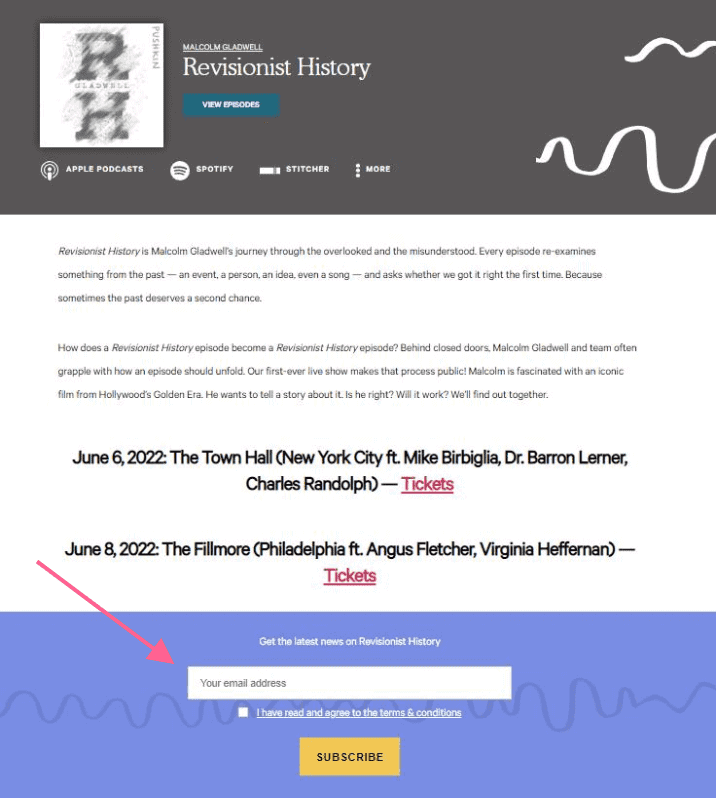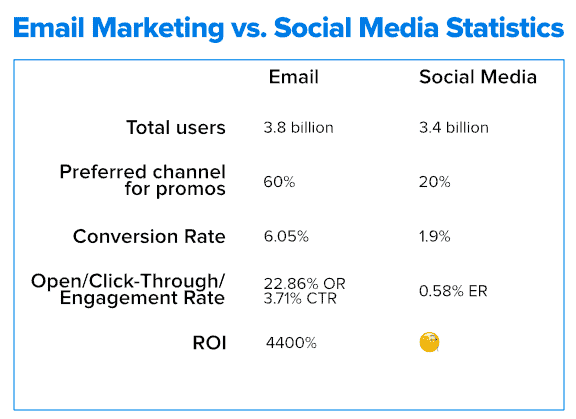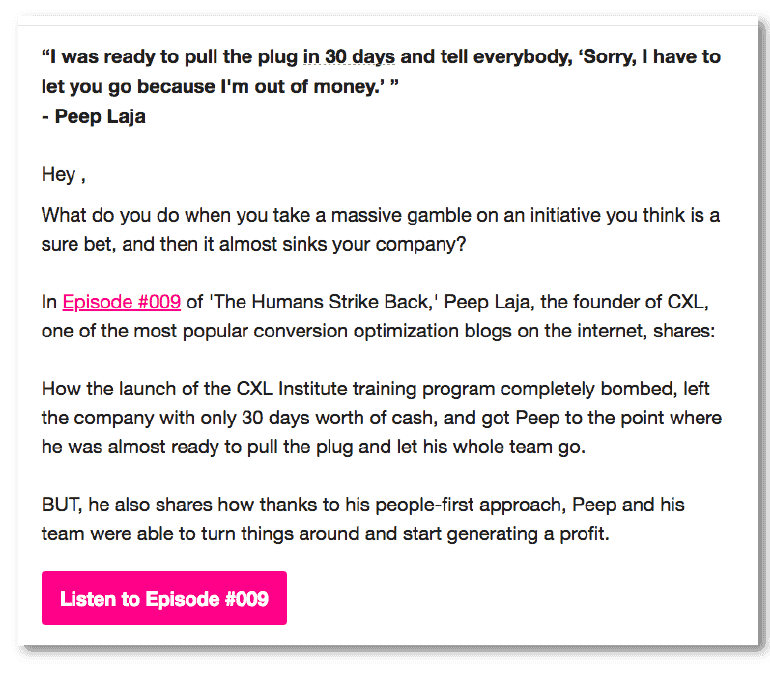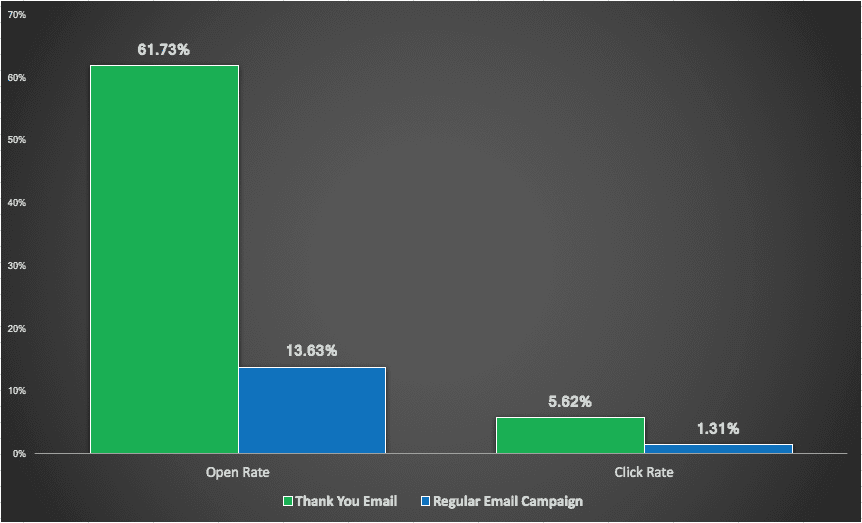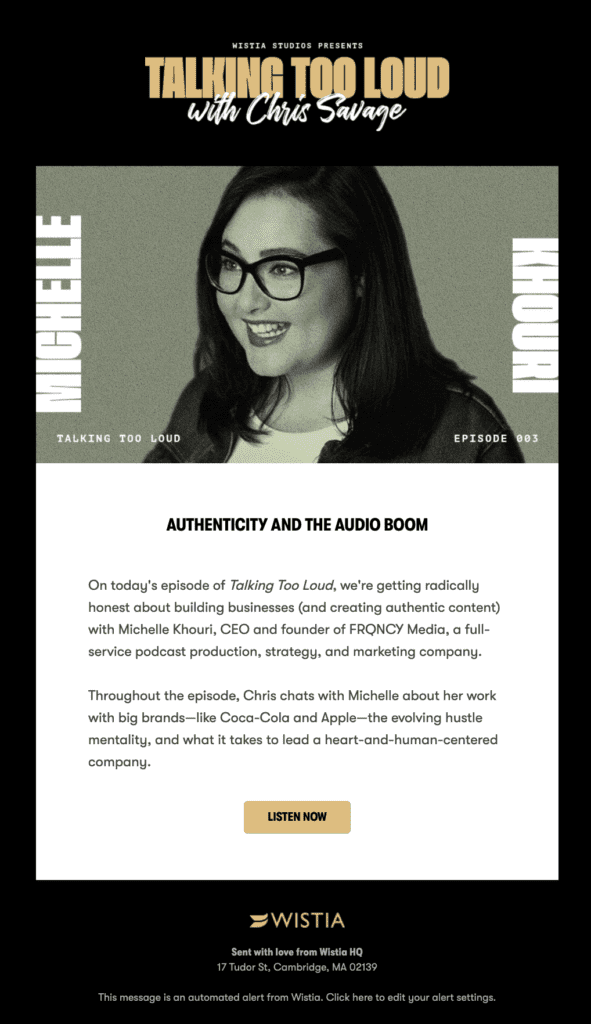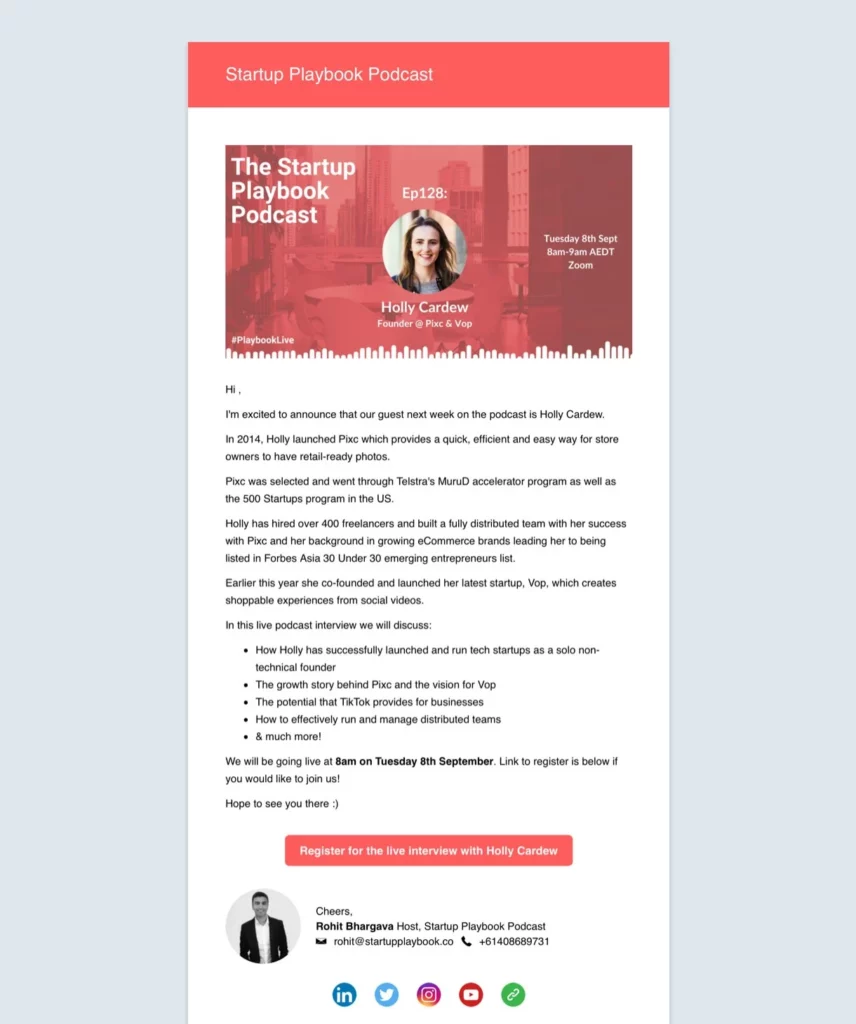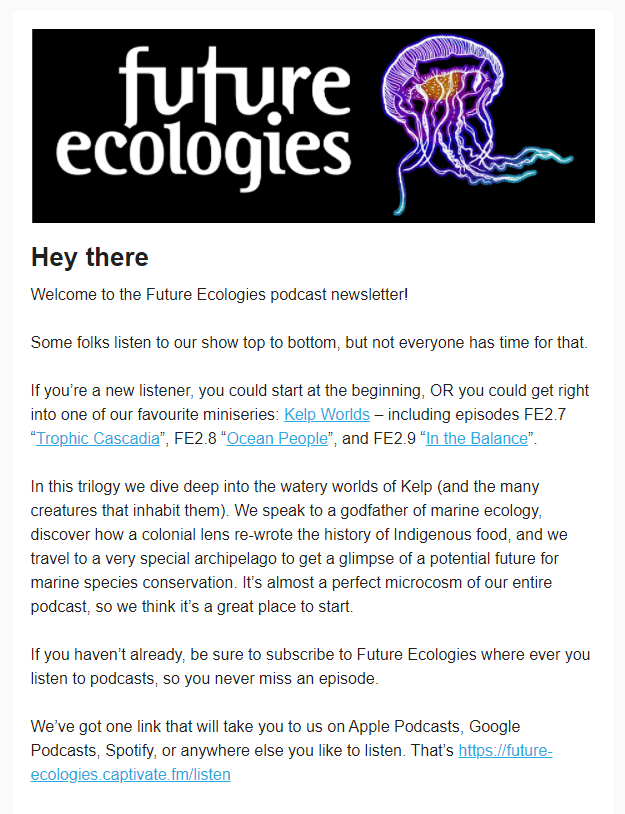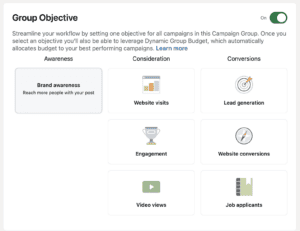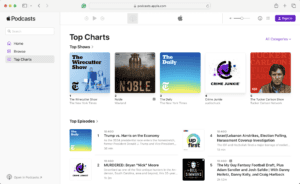Podcast email marketing is a powerful way to promote your show, build an audience, and continually engage with your listeners. It can also help you gather feedback and drive your fans to your new episodes.
Whether you’re a veteran podcaster or just starting your show, email marketing should be a component of your overall marketing strategy. In this guide, we’ll explain everything you need to know about podcast email marketing. But first, we’ll dive into why this channel is an important piece to your podcast marketing strategy.
Action
Read to start your own podcast? Learn the nitty-gritty details of starting your own show in our comprehensive guide. Learn how to start a podcast.
Why Email Marketing for Podcasts?
Podcasts are one-way methods of communication. Plus you can only communicate when you publish a new episode. Email is a clever way to bridge the gap between episodes, keep listeners engaged, and give them the chance to speak directly to you.
Plus, email marketing works. Between $32 and $44 is made for every $1 spent on email marketing (depending on who you ask). 49% of consumers say they’re happy to receive promotional emails from the companies they like at least once a week.
Furthermore, 73% of millennials say that email is their preferred business communication platform, compared to postal mail, social media, texting, or phone calls.
According to Statista, 333.2 billion emails were sent in 2022. That number is expected to hit 376.4 in 2025. If you want to stand out as a podcaster who effectively drives listeners and customers with email marketing, you have to do email marketing well.
How to Build a Podcast Email Marketing Strategy
Email marketing has its own set of tactics and best practices that differentiate it from social media or paid advertising. We’ve laid out the essential steps to start building your list and effectively marketing your podcast.
1. Define your email marketing goals
There are lots of ways to use your email campaigns to help grow your podcast and your brand. You might use email to sell memberships or products. You might use your email list to turn website visitors into listeners. Or, like a lot of podcasters, you might use your podcast email marketing to simply notify your subscribers whenever new episodes are available.
No matter how you intend to use podcast email marketing, just make sure you understand your own intentions so your emails are clear and serve your needs.
2. Choose an email marketing service
In order to send email content, you need to use an email service provider. This platform will let you design emails, send as often as you like, segment your audience, review analytics, and more. Ideally, it should also integrate with your other tools.
Which email marketing platform should you choose? There are lots of choices, so you’ll need to find one that meets your needs, but we recommend the following tools:
3. Begin building your email list
In order to send email content, you need a list. Your first step is to add subscriber signup forms throughout your site. Your email marketing platform will supply the code to embed in key places, like your sidebars, footers, in popups, or at the bottom of blog posts.
Alternatively, you could use forms from third-party plugins and services, but you’ll need to follow their steps to link them to your email marketing platform. During this time, you should also do email warmup with the service you use. This will prevent your first batch of emails from being marked as spam.
Additionally, make sure to validate the emails collected to ensure they are accurate and active.
How do you get people to subscribe to your email list? Let’s go over some simple strategies:
Ask for signups
The first strategy is the simplest: Just ask people to subscribe to your email newsletter. Put your signup forms in place they would normally explore, like your episode pages or in a popup that hits them after they’ve explored your site. Notice how Revisionist History puts a signup box beneath each episode.
Then, ask for signups in your podcast itself. Encourage your followers to visit your website and subscribe. Give them a simple URL they can remember, like yourdomain.com/subscribe. Explain how much it would benefit you and your brand.
Create a lead magnet
A lead magnet is a piece of valuable information that you provide to people in exchange for their contact information. In this case, we’re looking for their email address. Here are a few lead magnet best practices:
- If you have existing content related to your podcast subject (blog articles, for instance), compile that content into a single, comprehensive resource.
- Create a lead magnet related to your podcast subject. If you try to promote your entrepreneurship podcast to Justin Bieber fans, you’re going to have a bad time.
- Make your lead magnet comprehensive. If you decide to start a blog, it’s best practice to promote your lead magnet within your posts. Consider language like “For a complete guide to [subject], check out our new ebook, “[Title].”
If you need to start a new website to house your lead magnet, use one of the top website builders like WordPress, Wix, Squarespace, or Weebly to create a website without having to be a coder or designer. If you already have a website, add a landing page for your lead magnet.
Next, you’ll need a tool which enables you to create lead magnets worth providing an email address for. Google Slides can be an effective ebook creation tool. The best way to get started is to download an ebook from a publisher you love, then put their pages side-by-side to Google Slides, and try to duplicate what you see.
Develop custom landing pages
Once you have your lead magnet, put it behind an email-gate on an optimized landing page, and then drive traffic to it. An email gate is a simple tool which delivers your lead magnet content after people provide the required information (in this case, an email address).
Landing pages can be created in-house by your developer, but most podcasters and digital marketers use a landing page builder. These tools create templates that are optimized for conversion. Some landing page optimizations include:
- A value proposition or unique selling point, which makes it very clear what value your visitors can expect to get from your lead magnet
- A single call-to-action (CTA), which focuses your visitor’s attention on your goal (submitting their email address in order to get your lead magnet)
- Limited navigation options, so your visitors don’t get distracted by other links
- Visual cues like high-contrast color on the objects you want to draw attention to
- Hidden, or few forms. The example below, for instance, includes a click popup which will only show when the landing page visitor clicks on the CTA button “Book Free Demo.”
Drive traffic to your landing page
Now that you have your lead magnet and landing page, it’s time to start driving traffic. The first option to do that is with social media.No matter your podcast’s subject, whether it be a marketing podcast or politics podcast, your prospective listeners (and prospective email subscribers) will be on social media.
If you’re wondering why you should bother turning social media users into subscribers, it’s because email is better than social media at driving listeners to your podcast, and it’s not even close.
If you get someone to subscribe to your email list, you’ll average a 22% open rate. With social media? You’re lucky to have 1% even see your posts when you release a new podcast episode.
Build out several social media profiles for your show. Then create awesome content that drives your followers to your lead magnet and other subscription pages. Use a social media scheduler and batch out your content to automatically post so you can easily drive social media users to your lead magnets.
What should you share on social media? Check out our podcast promotion template and our complete guide on podcast marketing for more information.
Buy paid advertising
If you have a bit of budget and are pushing for a big launch of your new podcast, paid advertising may be the way to go. There’s no more effective way to drive targeted traffic to your lead magnet and email list than with Facebook Ads or Adwords display ads. Through PPC you can funnel in tons of traffic to build your email list and turn them into everyday listeners.
Podcast Email Marketing Content Ideas
While most of your podcast newsletters will be notifications about new episodes, there are lots of different kinds of content you can send to your subscribers. Remember, you aren’t just trying to push people to your podcast. You’re trying to build a relationship with your fans.
Here are content ideas for your podcast email campaigns:
- Show notes – Include the show notes right in the body of the email
- Behind the scenes audio or footage
- Promotional offers for courses or merchandise
- Celebrate milestones, achievements, and anniversaries
- Personal messages to your fans
- Recaps or roundups of latest episodes
- Industry trends or news
- Aftershow content – Recording that didn’t make it into the show
- In-person events or meet-and-greets
- Further reading or extra materials
- Listener responses or discussion points
Action
Your new episode notifications are an important component of your podcast email marketing. Check out our guide on crafting your own podcast announcements. Want a quick way to send episode notifications? Check out our post on quick podcast newsletters.
Podcast Email Marketing Tips
You can’t just write “Go listen to my podcast” in an email and expect your new list to head straight there. This section will give you some powerful tips to produce awesome email marketing content for your subscribers.
1. Write better content
The first and most important thing to remember when using email marketing for podcasting is to avoid losing subscribers you’ve worked hard to get. The quality of your email content will dictate whether users will regularly open and engage with your messaging. Use the below best practices to write better copy:
- Write for intent: What do your email recipients want to learn? Communicate the value of your podcast at the top of every email with smart copywriting.
- Write for your audience: Who is your audience? Are they young professionals, or older management-types? Should your tone be casual with emojis, or professional?
- Use emotion: People respond to emotion far more than neutral language.
- A/B test your subject lines: Nothing has a more significant impact on your email effectiveness than the rate at which your new subscribers are opening your emails. Be sure you’re using an email tool which enables subject line A/B testing, and keep track of what works!
Here’s an example of a good podcast email from Hotjar:
What makes this a good email? Let’s break it down:
- The quote at the top of this email is an example of pure emotion. There’s no way to more effectively grab your email subscribers than with emotion.
- The high-contrast pink draws the eye very effectively to both links to the podcast. And having two links is also best practice.
- Though it’s not shown (as this is an example taken directly from Hotjar’s email marketing tool), the space before the comma at the top shows us there would normally be a first name merge tag there. Personalization is crucial to continued engagement from your contacts.
- Starting with a question. Questions are fantastic hooks, as they inspire people to keep reading – either to see if the question is answered or (having answered it themselves) to see if they got it right.
2. Personalize each email
If you ask for the first name of your new email subscribers, use it! A simple merge tag could have a huge influence on your email’s open rates. Let alone the effect on reduced unsubscribe rates, click-rates, and general loyalty to your podcast.
“79% of companies that exceeded their revenue goals also have a documented strategy for personalization.” Always use personalization to your advantage.
3. Segment your podcast audience
Segmentation is the practice of categorizing your subscribers into groups based on criteria that helps you personalize your email content. For instance, if your podcast discusses business topics, you might set up segments for “small business owner” or “large business owner.” Then you can tailor content to each group so everyone reads something that seems just for them.
Email segments can be based on anything, such as their interests, demographics, or the way they interact with your email content. You could even send surveys to your audience so they can filter themselves into the right segments automatically.
4. Send thank you and welcome emails
With an average open rate of 61.73%, thank you emails are between 400 and 500% more impactful than regular emails. Welcome emails are even better, with a reported 82% average open rate. As soon as someone subscribes, send a thank you or welcome email with a call-to-action to subscribe to your podcast.
Open and click through rates of welcome and thank you email campaigns. They may be the only email they ever open from you. Make sure that email prompts them to check out your podcast.
5. Track your successes and misses
Keep track of what’s working in your emails. What types of subject lines drive more listeners, which call to actions garner the best engagement, what images work best?
Here are a few relevant tools to turn email subscribers into listeners:
- Grammarly: Grammarly’s “set goals” feature allows you to tell the tool what you’re looking to achieve with your email. After setting your goals, copy and paste your emails into Grammarly before you hit send to make sure our copy lines up with your objectives.
- MailTracker: MailTracker by Hunter is a simple and free email tracker for Gmail that lets you find out who opens your emails. Once you’ve added the extension, your emails are tracked via Gmail. Then once someone opens your email, you can check out the details and assess what emails are working or not.
6. Reward subscribers with discounts
You could choose to make your subscribers automatic premium members, or prompt them to pay to access your premium podcast content. Either way, keep your subscribers loyal with additional value exclusive to them.
And don’t beat around the bush when you talk about the offer’s exclusivity. Exclusivity is part of a psychological phenomenon called the scarcity principle, which states that the rarer something is, the more valuable it is (even if there’s no real additional value).
7. Use the P.S. to push them to take action
If the main call to action in your emails is to listen to your podcasts, your second should be to complete some kind of purchase or advance down your business’ sales funnel. And that call to action should go in the P.S. of your email.
There’s something called the Zeigarnik effect, which says that humans have a desire to complete tasks. Uncompleted tasks (like not reading the P.S. in an email) creates tension. In short, people pay close attention to the P.S. in your emails, so make sure they see the value of making a purchase.
8. Use clear and simple email design
Simple, easy to read emails are always best. You want your subscribers to focus on the content and click your call-to-action, not get lost in the design. Use some basic branding or podcast artwork so they know who the email is from right away. Then get right into the content.
It’s also smart to add ALT text to each image. This serves as a descriptive backup in case the recipient has turned off their images or if they have a reading disability. In order to make your workflow simple, save your email template so it can be resued over and over. This way you can create email marketing campaigns quickly.
Talking Too Loud has an excellent podcast email design. All of the information is packaged succinctly and the call-to-action is clear.
9. End with a clear call-to-action
Since the purpose of an email is to get the recipient to take the next step, it’s important to end every email with a call to action. This refers back to those goals you set up during your strategy.
In most cases, your call to action will spur the reader to click to the latest episode. In other cases, you might ask them to engage with you on social media, join your private podcast group, view your membership course, or check out your merchandise for sale.
10. Embed your social media and listening links
Each email should include some links in the footer so your recipients always have access to your content. Make sure to include links to all of your social channels as well as links to your show on various podcast listening apps. Notice how this email from the Startup Playbook Podcast puts all of their links in the footer.
11. Mention your sponsors
If any of the content in an email campaign is sponsored by an advertiser, be sure to include a line somewhere in the email that acknowledges this. It’s important that your subscribers can differentiate between organic and paid content. In many jurisdictions, this is also the law.
12. Celebrate milestones
Don’t be afraid to email your subscribers whenever you achieve something big. They want to hear about your success. Send an email whenever you win an award, surpass a big number of subscriptions, pass an anniversary or land an important guest.
Remember: Every email should ask your subscribers to take the next step. Your milestone notifications are no exception. Find ways to prompt your audience to do something that helps grow your brand, like share your show or follow you on social media.
13. Created automated email campaigns
Automated emails are campaigns that are sent based on pre-set conditions. When a subscriber meets the campaign’s criteria, the automation kicks off by sending the first message. Campaigns can be one email or multiple emails with delays in between.
The most common example of an automated campaign is a welcome series. This series is typically three to five emails that introduce the brand and tell the new subscriber anything they need to know. Here’s an example from Future Ecologies.
Automated campaigns are great ways to have conversations at scale with your audience. For instance, let’s say you have a tag or list for subscribers who love dogs. You could set up an automated campaign with your dog content. When your email marketing platform assigns that tag to a subscriber, they immediately get your dog emails.
The Top Email Marketing Podcasts
Want to learn more about email marketing? We recommend these top email marketing podcasts:
- Email’s Not Dead
- The Email Marketing Show
- Email Einstein
- The Future of Email
- Humans of Email
- Inboxing
- Inbox Besties
Podcast Email Marketing Key Takeaway
Email marketing can be the difference between a successful podcast and a flop. Use email marketing to convert podcast listeners into subscribers so they remain engaged with your brand. Craft compelling, personalized emails to ensure your podcast gets the attention it deserves. It won’t be long before email is one of your most powerul marketing channels.

